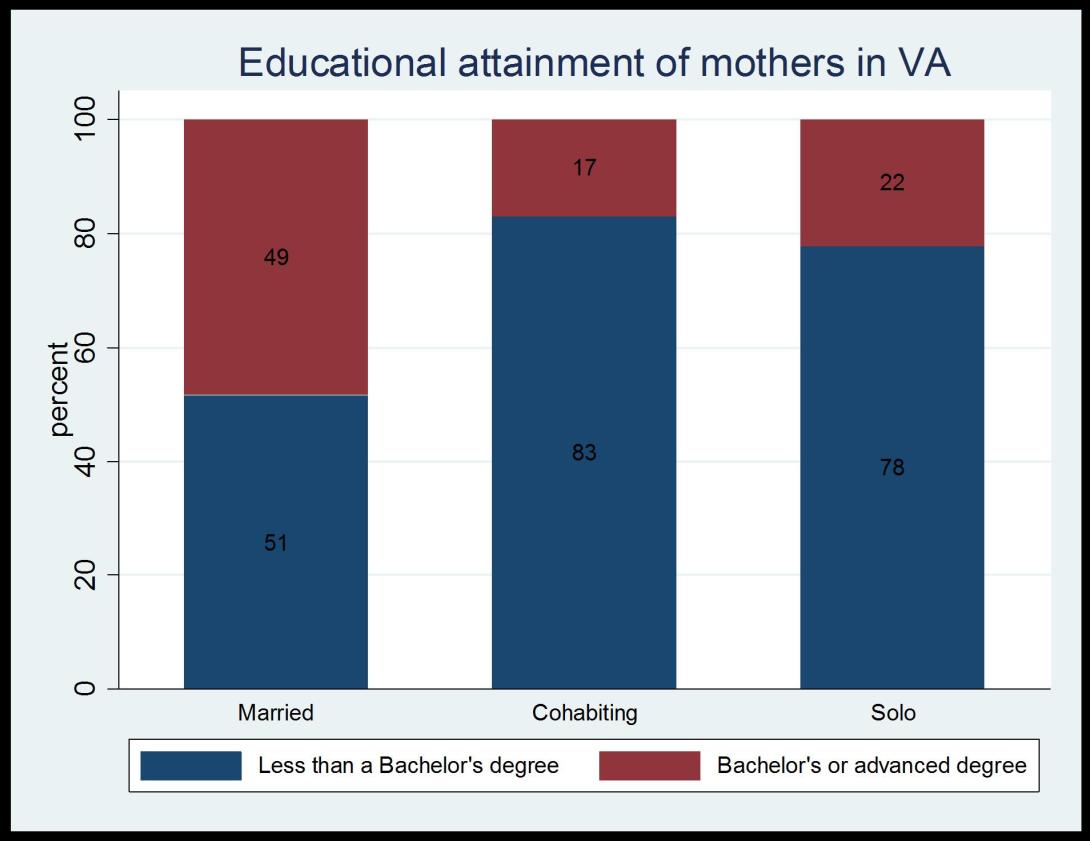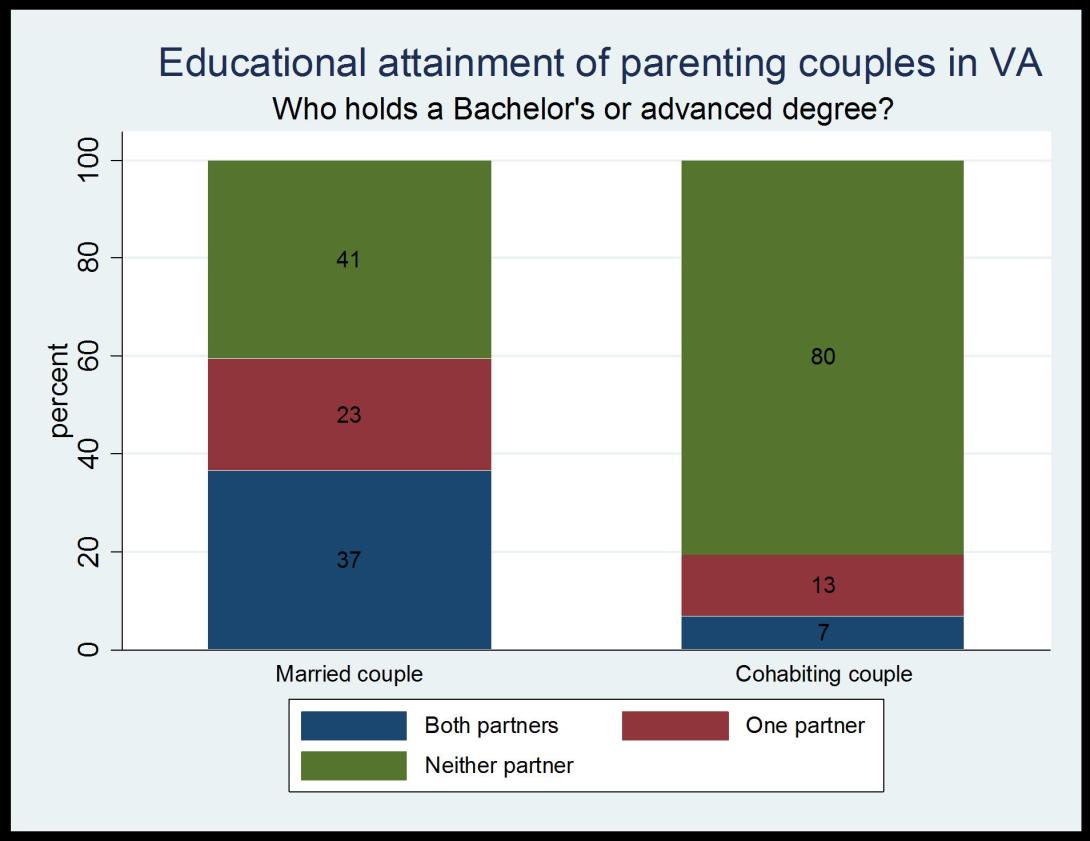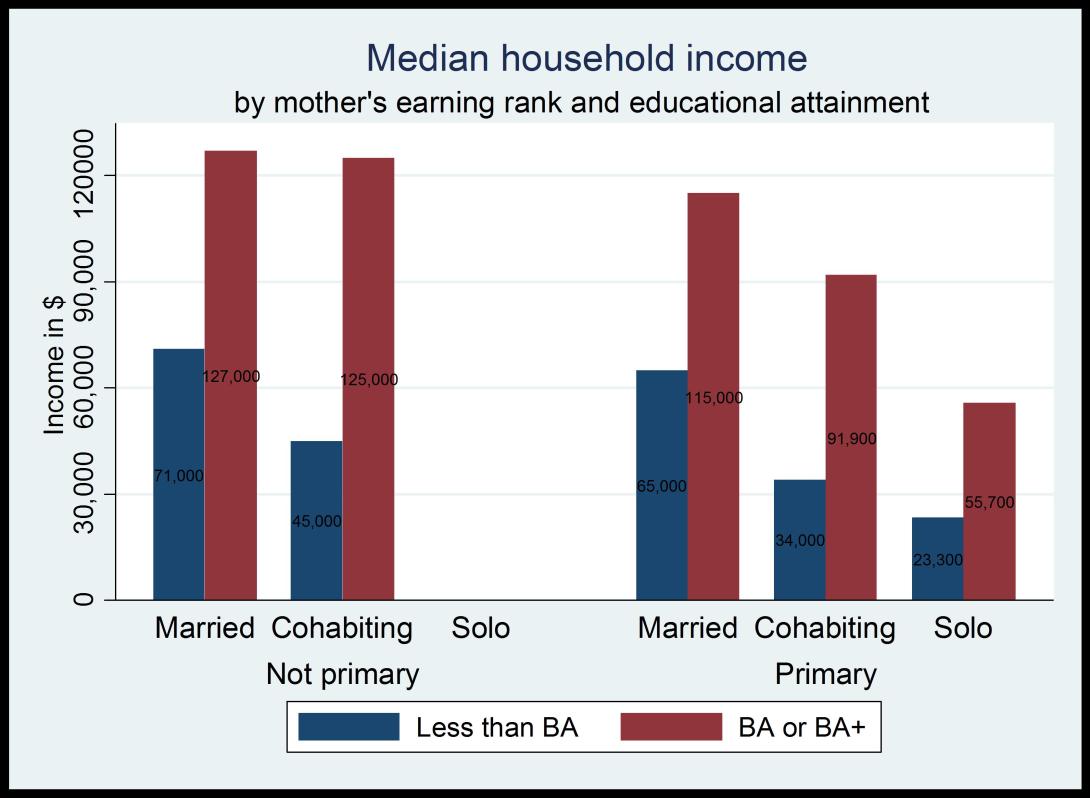Breadwinner Moms in Virginia: A closer look at unmarried mothers
As mentioned in a previous post, much of the research and conversation about “breadwinning” mothers simplistically distinguishes between only two groups: married and unmarried mothers. But there is a third group that is often not considered—women who are unmarried, but living with a partner.
Non-marital cohabitation is on the rise in the United States: In 2009, the number of 30-44 year olds living in an unmarried (heterosexual) partnership was almost double what it was in the mid-1990s. To more fully understand the economic status of Virginia’s mothers—to make the “breadwinning moms” story more precise—it is important to take a look at this third group.
In this post, “cohabiting mother” means any unmarried woman living with at least one of her minor children as well as a partner of either sex, while the term “solo” mother indicates unmarried mothers living without a partner. I was able to identify this population of cohabiting Virginia mothers using data from the 2011 American Community Survey.*
Cohabiting mothers in Virginia
Cohabiting mothers represent about 4 percent of all Virginia mothers, and about 16 percent of unmarried mothers. While this population is relatively small, it is worthy of notice for several reasons.
First, our calculation of the “female breadwinner” rate relies on a more precise understanding of women’s living arrangements. Recalling the definition of a “primary earner” as the individual in a household with the highest personal income (which includes not only wage and salary income, but also cash income from other sources, such as returns on investments), we see that:
- Among cohabiting women, about 37 percent are the household’s primary earner.
- This is a little more than 1.5 times the percentage of married couple households in which the mother is the primary earner (22 percent).
- However, if cohabiting women are counted among single women and assumed to be primary earners—even in the 2 out of 3 cohabiting homes where they are not—we estimate too high a rate of female breadwinners among the total population of females.
When we analyze female breadwinner status using only two categories (married versus unmarried mothers), it appears that 41 percent of Virginia’s households with children have a “breadwinner mom”. When counted more accurately, the percentage of Virginia households in which the mother is the primary earner is about 38 percent.
Second, beyond an interest in good measurement, it’s important to identify and describe cohabiting mothers as a distinct group in order to assess—and potentially address—what sets them apart. Let’s start with some descriptive statistics:

Not only are cohabiting mothers earning less in wage and salary income than their married counterparts, but cohabiting mothers are also earning less than solo mothers. This may be, in part, a function of age—since the average cohabiting mother is younger than other mothers, she may have less workforce experience. However, this trend persists even when we exclusively examine mothers under the age of 40.
Furthermore, among these three populations, cohabiting mothers are the most likely to live in poverty, as determined by the Federal Poverty thresholds. While 42 percent of cohabiting Virginia mothers may be considered “poor” by this standard, 37 percent of single (“solo”) mothers, and only 5 percent of married mothers, fall into the same category.**
So, with this kind of motivation in mind, let’s take a closer look at Virginia’s breadwinner mothers—this time, including cohabiting mothers as a distinct group.

The median cohabiting primary earner makes less in wages and salary than her married counterpart, though more than the median solo mother. Consistent with what we’ve seen with cohabiting mothers as a whole, she is also younger than either, with about as many kids. These children are slightly younger than those of either married or solo mothers.
While giving important background information on Virginia’s female breadwinners, these statistics do little to illuminate the entire picture. How about a look at educational attainment to reveal more nuance?
Education, cohabitation and earner rank
Consistent with trends brought to light by a previous Pew publication, the majority of cohabiting mothers in Virginia have less than a college degree. Furthermore, 80 percent of cohabiting mothers live in a partnership in which neither partner has a college degree, as compared to 41 percent of married mothers. Note, too, that solo mothers are slightly more likely than cohabiting mothers to have at least a Bachelor’s.


51 percent of cohabiting women with a Bachelor’s or advanced degree are their homes’ breadwinner, while among similarly educated married mothers, only 23 percent are the primary earner. While it is tempting to believe that this speaks to greater gender equity in cohabiting relationships, it’s important to keep in mind that this statistic reveals a pattern, not an explanation. However, it does suggest that we should let educational attainment factor into our examination. When we compare earnings across the college diploma divide, we see the following trends in household income:

Among the interesting patterns that emerge, we see that
1) Married couples’ median household income outstrips that of either cohabiting couples or solo mothers, though this difference in less pronounced in households where the mother does not have a Bachelor’s degree;
2) Couples in which the woman has at least a Bachelor’s degree have consistently higher median income, whether married or cohabiting, than those in which the woman does not;
3) While female breadwinner households have lower median incomes, it appears as though woman’s educational attainment is more strongly correlated with household median income than is the sex of the primary earner.
However, when we examine mothers’ wages and salary along the same divisions, a different trend emerges:

First, we see that college-educated solo mothers earn more in wages and salary, on average, than similarly educated cohabiting women. Furthermore, it appears that cohabiting mothers with at least a Bachelor’s earn more in wages and salary when they are not their households’ breadwinners. Unfortunately, the sample size for cohabiting mothers in Virginia with more than a BA is too small to figure out what may be going on, here. On the other hand, it is something worth examining on the national level.
While there are other patterns, correlations and—simply put—ideas, to explore, the most important point to make is this: Not all unmarried parents are, in fact, single. Let’s make sure we take that into account in the broader “breadwinner” discussion.
*About 86 percent of the women in the cohabiting sample are household heads, which means they had been labeled as unmarried mothers in a previous post. About 14 percent are the partners of the head of household; these women would not be accounted for in an analysis of married versus unmarried mothers. Furthermore, note that this population includes both opposite-sex and same-sex couples; same-sex cohabiting couples were always categorized as “female breadwinner” couples in this analysis.
** Those of you interested in the topic of measuring poverty may want to check out some posts from previous months.


